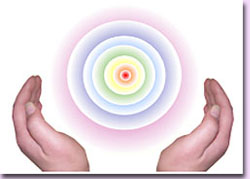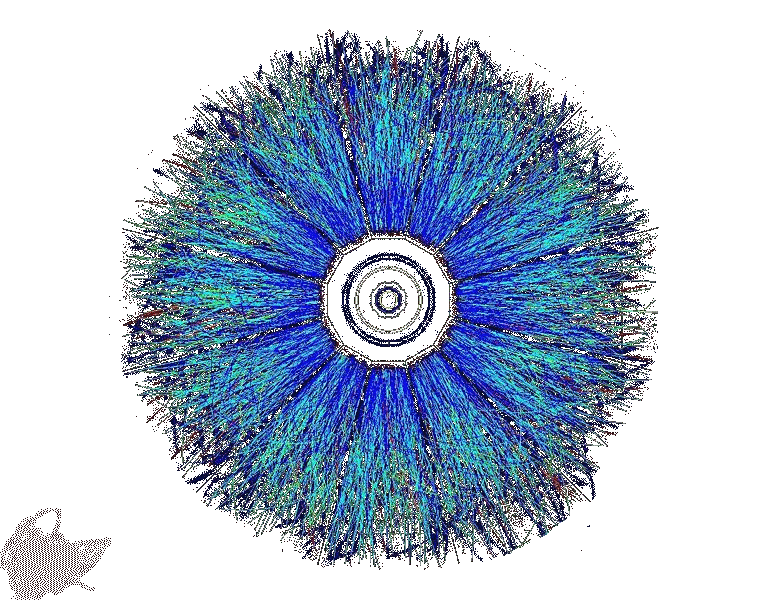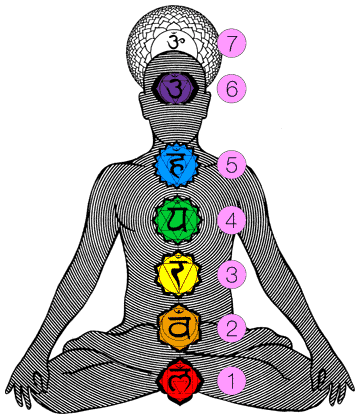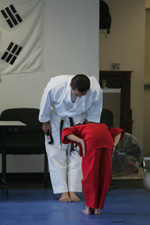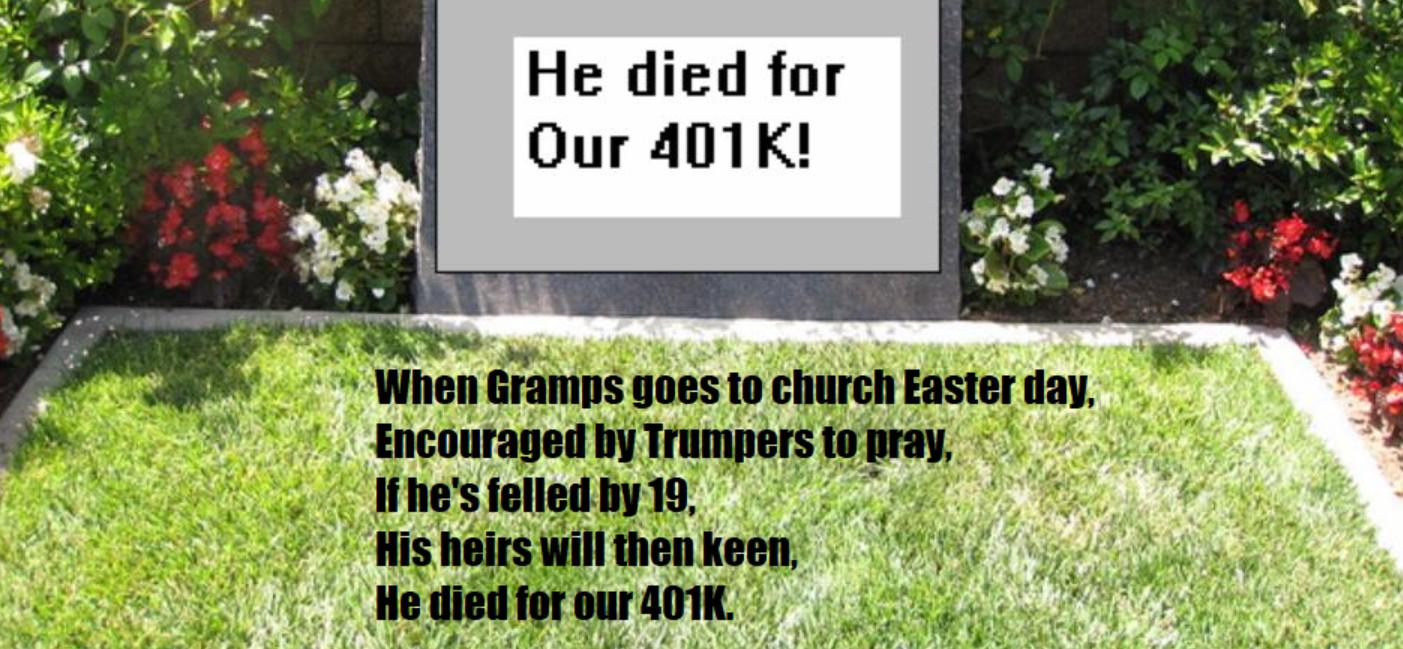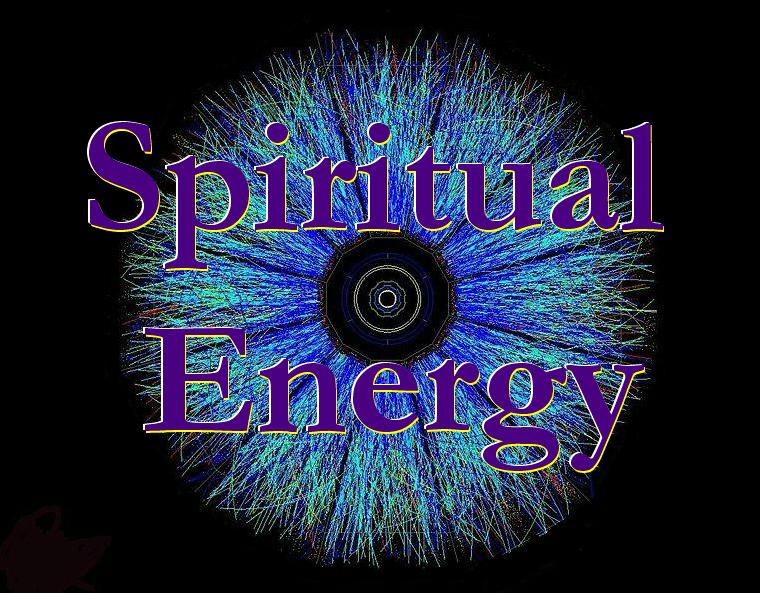
One of the major areas of teaching within the Perennial Tradition 1 is advanced instruction in how to understand, preserve, and use spiritual energy in self-transformation. The Perennial Tradition instructs in the esoteric application of higher configurations of energy possessing greater harmony, understanding, or power to improve and transmute lower energy fields--either locally or at a distance. Perennialist teachers use their advanced, more harmonized energy fields to assist in the development and transformation of the general populace and initiates.
| Contemporary scientists have come to the same conclusion as Perennialist seers that the basic element of Reality is consciousness manifested as energy. Physical energy is studied and described as particles and waves, since neither aspect is accurate by itself.
|
| |
| "Throughout mankind's cultural history there has existed the metaphysical concept that man and cosmos are interconnected by a ubiquitous, all-pervasive sea of energy that undergirds, and is manifest in, all phenomena. This pre-scientific concept of a cosmic energy goes by many names in many traditions, such as ch'i, ki or qi (Taoism), prana (yoga), mana (Kahuna), barakah (Sufi), élan vital (Bergsonian metaphysics), and so forth." 2 |
Nikola Tesla observed that the universe is a sea of energy. Today physicists know that matter is a form of energy, vibrating at different frequencies. Energy comprises 98% of the Universe and matter only 2%. "Every cubic centimeter of empty space contains more energy than the total energy of all the matter in the known universe." 3In sub-atomic physics, elemental reality is conceived of not as "things" but as foci of energy. Specific energy fields, manifesting through individual frequencies, assume distinct forms. All objects in our empirical world, then, are composed of energy frequencies, which when arrested, manifest through forms.
In this essay we'll explore the nature of spiritual energy and how it can be:
Understood
Transmitted
Preserved and Stored
Applied transformatively
"Everything a man does hinges on his personal power . . . Therefore, for one who doesn't have any, the deeds of a powerful man are incredible. It takes power to even conceive what power is." 4
Understanding and Transmitting Energy
We live in a universe of spiritual, psychic, and physical energy by virtue of which all living things exist through their ability to transmute this universal energy into something individual.
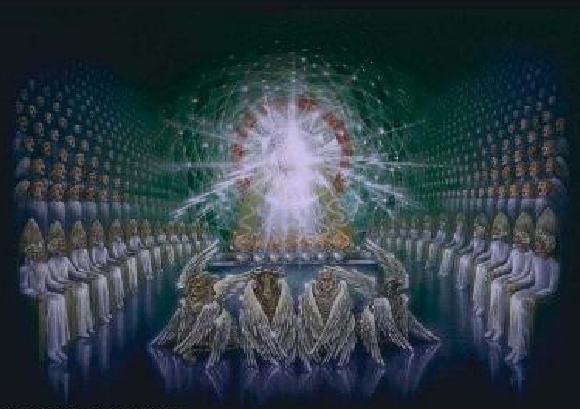 We work to attain the capability to transmit our own energy field, our individual unit of power. Humans are energy transformers; we are alive and developing in proportion to how much of this universal energy we accept and how freely it flows through us. The better we transmit this energy, allowing it to flow through us, the higher grade we occupy, the more foreceful and effective we become.
We work to attain the capability to transmit our own energy field, our individual unit of power. Humans are energy transformers; we are alive and developing in proportion to how much of this universal energy we accept and how freely it flows through us. The better we transmit this energy, allowing it to flow through us, the higher grade we occupy, the more foreceful and effective we become.Frederic W. H. Myers (1843-1901), an early investigator of spiritual and psychic energy, conceived of the subliminal self as being in touch with a realm of spiritual force from which it is able to draw energy to infuse into the human mind, and thus into human activities, ordinarily in limited quantities, but, in altered states, in great floods, which elevate the mental and physical operations and powers to exceptionally high levels.Myers viewed the brain as being at a comparatively early stage in its evolution as an instrument through which the higher self operates in the material world. He conceived of the subliminal self as that part of the Higher Self (soul) which remains unexpressed in
our conscious and organic life. The subliminal self surpasses the supraliminal (above the threshold of consciousness) or ordinary conscious self in its range of spiritual and psychic powers.
Our personal energy convergence point is a center of reception and radiation at the same time. The energy waves from the One Quintessence sustain us and are manifested in our separate frequency transmission. Our individual essence maintains itself by passing Higher Energy pulsations through it. The instant when the Higher Energy flows through us is our moment of absolute unity with divinity. The individual power which occasions the flow through of Higher Energy is composed of the sureness of our belief in the existence of this greater force.
Preserving and Storing Energy The universe is a web of energy conveying life force through its emanations. All entities within this network receive and transmit energy through radiations. A unitive experience of spiritual, psychic, and physical energy occurs as a direct response to the impelling force we create within ourselves.
| Whatever integration we achieve results in the issuing forth of energy from a higher dimension in direct proportion to our self-invigoration. We receive and transmit spiritual, psychic, and physical energy in direct relation to our developing intellectual, psychic, and spiritual capability. We learn to attune ourselves to the universal energy frequency, experiencing spiritual and psychic entrainment. 5
| |
All living organisms rely on an external sources of energy to be able to exist, to grow and to reproduce:
- Radiation from the sun in the case of green plants
- Chemical energy in some form in the case of animals
The energy we conduct of the Higher Force calls its complement into our being. Emanations of Higher Energy become available to transform our lives, recharging and repairing our own systems.
Energy upheavals shift us out of destructive habits, encouraging us to relearn integrative ways of being.
There are centers of energy physically and spiritually associated with various parts of our bodies, called chakras. When elemental kundalini energy moves through the various chakras, our consciousness necessarily changes. Each chakra is said to correspond to a specific mantra (sound) and geometric pattern (yantra). Through meditation on these chakras it is claimed that we can gain mastery over our body and each corresponding element.
The original undifferentiated energy from creation is termed Akasha in Indian philosophy and modern occult circles. In some embodiments of the Perennial Tradition it is termed the Secret Fire. This elemental psychic energy is completely instinctual and unconscious and is heavily influenced by spiritual, psychic, and psychological phenomena. One of the major functions of the Secret Fire is to increase human consciousness. At the lowest level, this is the ego, at its highest, it is the Higher Self.
| In the vast majority of humanity, this Secret Fire, or liberating energy of self-consciousness, is said to lie dormant at the base of the spine, coiled like a serpent. By learning to contact the various focal points of energy, what are called the chakras, the person moves her locus of consciousness into the various areas. If the Secret Fire reaches the top of the skull and beyond, spiritual awakening can occur, allowing for a descent and re-ascent of the energy, during which the psychic centers can be awakened, allowing for the manifestation of psychic powers and related phenomena. |
The Secret Fire is directly linked to sexual and creative forces in humans. Sexual desire can act as one of the basic evolutionary impulses, along with Higher Intellectual forces. The dormant capability and need for positive orgasmic experiences is biologically and psychically rooted. Sexual experience within the context of genuine love involves experience of spiritual transcendence, foreshadowing ecstatic union with the One. The "little death" or petite morte of the sexual orgasm, is a forerunner of the "big death" as we let go and experience divine oblivion.
Psychological Interpretations of Psychic Energy Theorists such as Sigmund Freud and researchers such as Wilhelm Reich studied psychic energy from a psychological perspective, viewing it as a complex mental, sexual or libidinous energy in our unconscious. Psychological afflictions were said to be the result of blockage of psychic energy.
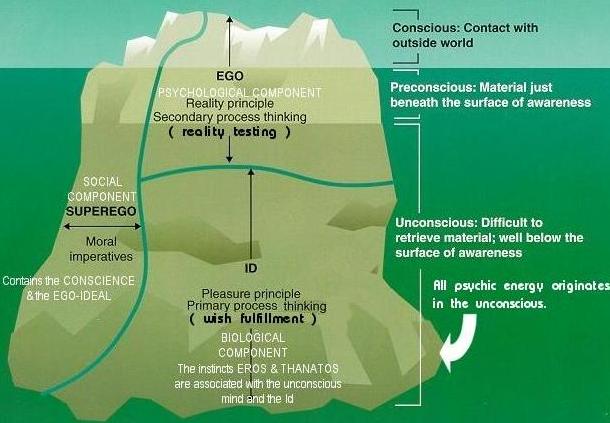
-
According to Freud, all behavior is motivated by the desire to feel pleasure. That motivation is organized and directed by two instincts: sexuality (Eros), and aggression (Thanatos). Freud conceptualized both these instincts as being powered by a form of internal psychic energy that he called the libido, a basic energy pool.
Freud believed that humans must subordinate their desire for pleasure--primarily sexual in nature--to the reality principle: the demand to live in conformity with socially concocted dictates, such as the subordination of women and children to a domineering, abusive father. Life thus becomes a joyless compromise with dysfunctional rules.
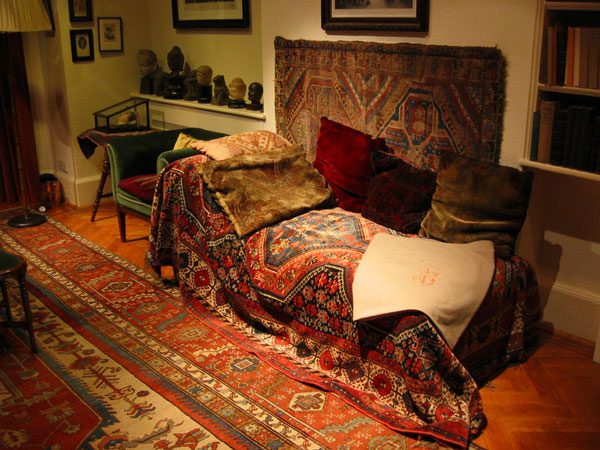 As we've seen, the sexual drive can be used in positive ways within the context of a mature love relationship. In most persons in contemporary society, however, the libidinous drives are thwarted or corrupted, resulting in psychological disorders of one form or another. Freud's psychoanalytic techniques--a silent therapist listening to the free associations and dreams of the patient--was a gigantic fraud, 6 resulting in persons becoming more miserable and neurotic rather than more functional.
As we've seen, the sexual drive can be used in positive ways within the context of a mature love relationship. In most persons in contemporary society, however, the libidinous drives are thwarted or corrupted, resulting in psychological disorders of one form or another. Freud's psychoanalytic techniques--a silent therapist listening to the free associations and dreams of the patient--was a gigantic fraud, 6 resulting in persons becoming more miserable and neurotic rather than more functional.
Other psychologists and psychiatrists such as Wilhelm Reich 7 and Erich Fromm saw the absurdity and devastation of counterfeit therapies, such as orthodox psychoanalysis, and developed new approaches to freeing psychic energy from social and personal obstructions and debasements. Reich's and Fromm's psychotherapeutic practices were positive in their effects, unlike Freud's. However, these approaches to relieving psychological and spiritual disorders operate entirely within the physical or psychological sphere--not in the spiritual domain.
Perennialist Procedures
Just as our current civilization uses various energy forms such as electricity, magnetism, and electromagnetic waves, seers within the Perennial Tradition preserve and use spiritual energy. This more subtle form of energy operates according to specific principles which it is essential to learn and practice. Just as electricity is potentially deadly if handled by a person ignorant of its power, so spiritual energy can be lethal if trifled with by the spiritually illiterate.
Spiritual energy can be directed by concentrated meditation, which is how prayer and spiritual healing work. Perennialist meditation focuses and transmits spiritual energy, directing it to a specific location for a specific purpose.
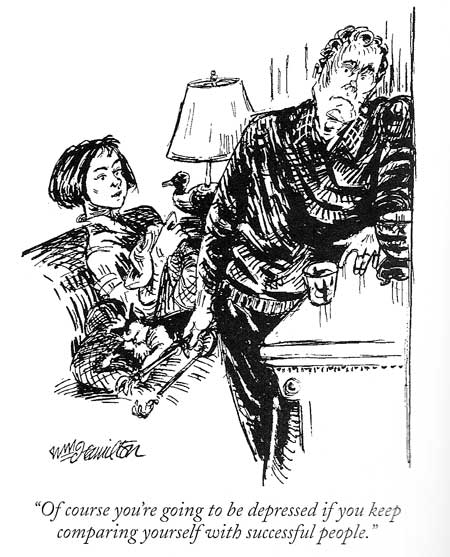
Since external and internal energy focal points affect our bodies, minds, and states of consciousness so directly, we must carefully select the inputs we allow into our experience: persons, activities, images, thoughts, feelings, food, sounds, written material, and environmental elements.Every time we interact with another person, there is an exchange of energy resonance. Extensive interaction with people possessing negative energy fields may debilitate us and leave us with a tremendous amount of harmful energy debris.
Unless we learn to recognize negative energy and cleanse our fields of it, we can suffer physical, emotional, mental, and spiritual problems. Fortunately, the opposite is equally true: spending time with positively charged persons and edifying phenomena such as enlightening music, art, and literature, 8 can bring transformative effects.
Our spiritual and psychic energy can be misused or wasted in a number of ways. Negative mental and emotional states allow for leakage of energy at a rapid pace (as if we punctured a balloon with a pin, creating a hole and resulting in the baloon exploding or the air slowly leaking out). One of our greatest enemies in this regard is self-importance. We allow ourselves to be weakened by feeling offended by the deeds and misdeeds of other people. Our self-importance requires that we spend most of our lives offended by someone.
Appropriate self-regard is certainly an important factor in any healthy conception of oneself, but what we're referring to is what might be called malodorous self-importance or pomposity. Perennialist savants teach students to overcome all aspects of what is called the debilitating self, a major element of which is self-importance. Students are taught the proper procedures to preserve, store, and use spiritual and psychic energy. Initiates are taught to take strategic inventories of what they do--especially their non-essential behavioral patterns--to determine what can and should be forfeited to save and store energy. Stored energy is used to transform oneself.
It's first necessary to identify with our Higher Self and develop a moment-to-moment awareness of what's happening in our personal energy fields and the energy networks affecting us. We learn to notice how we feel around certain people and in certain situations, for example whether we feel energized or enervated. Power struggles are about "stealing" each other's energy. If you feel "drained" after having been with a specific person, you're probably "losing energy" to that person. 9
We can develop the ability to observe our emotions and thoughts as they occur. If we come in contact with a person or idea--face to face or while watching movies or television--that regularly "pushes our buttons," we must learn to control our energy field so unconscious reactions don't wreak havoc in our emotional life.
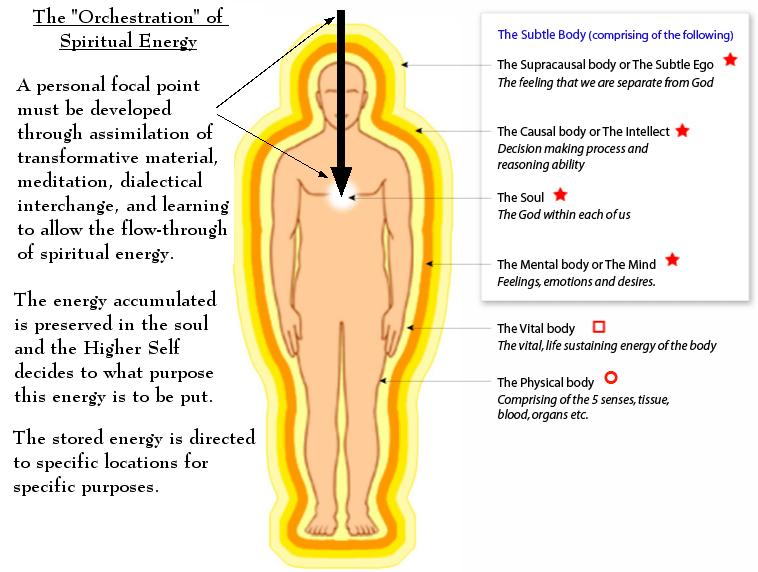
In previous essays, we've explored the ways in which Perennialists work with spiritual energy phenomena such as inspiration, interpersonal interchange, spiritual sexuality, and creation. In the concluding section we'll focus on two procedures used in the Perennial Tradition dealing with energy:
- The orchestration of energy in connection with the eye center
- The use of an opponent's weakness to overcome or transform him
The "Outer-Directional Energy Flow" Disposition
With egomaniacal, self-important persons, spiritual and psychic energies normally flow outward into people, events, and objects in the external world.
This phenomenon is usually "seen" by us as the person being "self-conscious" or "self-important" to a greater or lesser degree. We sometimes say of such people that they're "full of themselves," "always on camera," or that they try to "charm" other people. What we mean is that their energy is flowing outward through their bodies, especially thier eyes, to "see" what others are thinking and feeling about them, attempting to pull other persons' energy toward or into them.
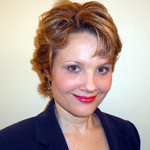
The "outer-directional energy flow" disposition isn't limited to one type of person; it can be a woman who calls herself "juicy" or a guru who believes himself to be divine. It's clear from their outward eye-energy focus that their locus of consciousness is "out there," looking for approval or adoration. 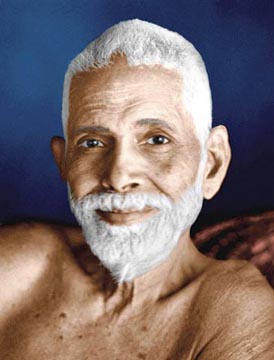
The "outer-directional energy flow" syndrome is not always present in mere show-offs. Such "constantly on stage" performers may or may not have an outer-directed optical energy flow.
The "outer-directional energy flow" can be most easily seen when it occurs in connection with a person's eyes. However, the same uncontrolled energy discharge can transpire in relation to other dysfunctional behavioral phenomena such as irrepressible "talking," ungoverned negative thinking, and uncurbed destructive actions.
The Perennial Tradition teaches how spiritual energy must be accumulated and preserved, then transmitted to persons, events, and objects in connection with specific goals set by the Higher Self. This requires that most of the time a person must be accumulating and preserving spiritual energy, not "leaking" it through self-importance, negative emotions, or destructive actions. In regard to optical energy flow, spiritual energy must be made to "flow backward" through the eyes, back into the mind (not the brain). In Perennialist teachings this is termed the "death of the senses." The energy flow in the Intellect must be inward as well, and this is called the "death of the monkey-mind."
The teachers who provide the most illuminating explications of this teaching are Plato and Francois Fenelon, in his work entitled Spiritual Progress. Fenelon was not a Perennialist teacher, but was strongly influenced by Perennialist thought and was a conduit for transformative material.
Plato made it clear that the ultimate attainment of unitive consciousness is possible only through muesis (literally, "closing of the eyes"): turning away from external sense-data and discovering truth through an introspective process of contemplation and meditation.
In the Phaedo, Socrates (Plato) reveals the secret nature of philosophy.
"I hold that the true votary of philosophy [the search for wisdom] is likely to be misunderstood by other men; they do not perceive that his whole practice is of death and dying. . . . When the soul exists in herself, and is released from the body and the body is released from the soul--death, surely, is nothing else than this. . . . In matters of this sort philosophers, above all other men, may be observed in every sort of way to dissever the soul from its communion with the body . . .
"When does the soul attain truth? . . . Must not true existence be revealed to her in contemplation, if at all? . . . And contemplation is best when the mind is gathered into herself and none of these things trouble her--neither sounds nor sights nor pain nor any pleasure--when she takes leave of the body, and has as little as possible to do with it, when she has no bodily sense or desire, but is aspiring after true being . . .
"If we would have pure knowledge of anything we must be quit of the body--the soul in herself must behold things in themselves; and then we shall attain the wisdom which we desire, and of which we say that we are lovers. . . .
"True philosophers. . . are always occupied in the practice of dying. . . ."Philosophy, Socrates is saying, is the actual practice of learning to leave the physical body and live in the spiritual body, which is called "dying."
The teaching of Fenelon (1651-1715) is similar to that of Plato: focusing on the inner Higher Self.
"They should be taught to begin by an act of profound adoration . . . before God, and closing the corporeal eyes, endeavor to open those of the soul; they should then collect themselves inwardly, and by a lively faith in God, as dwelling within them, pierce into the divine presence; not suffering the senses to wander abroad, but holding them as much as may be in subjection.
"Then let a lively faith in God immediately present in our inmost souls, produce an eager sinking into ourselves, restraining all our senses from wandering abroad: this serves to extricate us, in the first instance, from numerous distraints, to remove us far from external objects, and to bring us nigh to God, who is only to be found in our inmost centre, which is the Holy of Holies wherein He dwells."
To attain unity with the divine in our "inmost centre," the "Holy of Holies wherein He dwells," we must close our corporeal eyes, keeping our senses from "wandering abroad." When a Perennialist teacher is working directly with a student, the consideration of spiritual and psychic energy becomes an important factor. Sometimes, students have not developed a fully functioning inner core, so any energy they happen to encounter is uncontrolled, resulting in negative effect and the leaking of energy as soon as it is stored. It's often necessary for students to close their eyes when they're engaged in transformative communication (listening or dialectic) or engaging in Perennialist exercises to avoid the dispersal of energy through the eye center. This allows students to avoid energy leakage and gain an awareness of inner energy dynamics.
"The only method of effecting unity, is inward recollection, by which the soul is turned wholly and altogether inward, to possess a present God. If it direct all its vigor and energy within, this simple act separates it from the senses, and, employing all its powers internally, it renders them faint; and the nearer it draws to God, the farther is it separated from self."
Fenelon, Spiritual Progress
Overcoming One's Opponent By Utilizing His Weakness Perennialist teachers instruct initiates in a form of spiritual "judo:" the art and practice of using an opponent's weaknesses--or falsely supposed strengths--to overcome or neutralize him. What is unique to this art is that we don't use brute strength to overpower an opponent, but rather skill, finesse, timing, flexibility, and adapting appropriately to changing circumstances. Economy of energy, balance, and grace are the outstanding hallmarks of the expert practitioner. Unlike the old Western gunslinger or the barbaric hand-to-hand fighter, the Perennialist "combatant" is soft and pliable, winning by appearing to yield.
Perennialist warrior-trainees first develop a comprehensive understanding of what kind of "warfare" they're engaged in: not a personal vendetta, a "one-upmanship" contest, or combat to prove who's most intelligent, brave, or powerful.
| "Imagine if you can a world in which truth is one general and
something we will call blindness is the opposing general. These two
simple factors one must choose between. There are no neutrals. We are
frankly for or against and hold our positions by the force of the effort
we put forth. The great struggle is not only to conquer our opposing
forces, but to reclaim and form them into fighters for the truth."
|
Perennialist "judo" involves learning how to use physical, psychic, and spiritual energy. An opponent attacking you is directing his energy toward defeating or destroying you. If you counterattack you're imposing your body energy against the oncoming thrust. Spiritual combat, on the contrary, redirects your opponent's energy instead of meeting force with force. As the attacker pushes against you, he finds you stepping to the side and allowing (often with the aid of a foot to trip him up) his momentum to throw him off-balance. Perennialist warfare requires you to be like a tree that bends to the wind instead of resisting unyieldingly and being uprooted and blown down.
| "A strong wind may destroy a sturdy tree; but the willow bends and the wind passes through." |
Spiritual "judo" involves the overcoming of negativities without inflicting injury. In some instances this is titled the "Art of Peace." One of the main factors is the use of precisely the amount of energy required to overcome an opponent--and no more. Whenever possible the antagonist's own energy momentum is used to overcome him, saving one's own force for times when it is necessary. Through comprehensive understanding of one's opponent's strengths and weaknesses, it becomes clear that overcoming negative elements such as egomania, ignorance, violence, and presumptiousness, responses such as anger, resentment, fear, and revenge are counterproductive and squander personal energy.
"The first application of wisdom is to accept opposition so in its entirety, so completely, that thereafter not one speck of attention power is ever wasted on it, except for the intellectual appraisement of its strength and the planning for control of its effect. "One of the most fundamental things about all the obstructive refuse you have to contend with, is that it has released its relationship with the ultimate source of life, and is cooling off and dying of decomposition. Once you realize and understand this, thoroughly, you will never be tempted to lose hope and give in. For with this engraved on your mind, it is impossible to entertain personal antagonism: you know too well the reason for things being the way they are. And once above personal antagonism, and aware of your own free power of relationship with the source, you find the way cleared for the bringing in of the fresh, healthy, over-laying material."
Betty White and Stewart Edward White, Across the Unknown
Instead of a head-on attack, the Perennialist warrior uses more subtle, sometimes indirect, methods, including satire, humor, and allowing the opponent's own words and actions to betray or expose him.
The two cultural manifestations that most closely resemble the Perennialist tradition of spiritual warfare are the Western medieval custom of chivalry and gallantry and the Eastern systems of judo and aikido. Chivalry and gallantry represent the quality of mind enabling one to face danger or hardship resolutely: with bravery, courage, dauntlessness, fearlessness, fortitude, gameness, heart, intrepidity, mettle, nerve, pluck, spirit, stoutheartedness, valiance, and valor.
Japanese polymath and educator Kano Jigoro (1860-1938) developed judo from his study of jujutsu and other martial arts. The word "judo" means the philosophical and spiritual path (do) of gentleness and suppleness (ju). Kano viewed judo not as a means to display physical prowess or superiority, but a way to live in peace with other human beings. As an educational leader, Kano combined intellectual training, moral culture, and physical education. Kano's view of judo included two great guideposts: "Best use of one's energy" and "Mutual welfare." Kano designed judo as a way to develop harmoniously the intellectual, moral, and physical aspects of the education of young people.
"The principle of gentleness is explained in brief as follows. Victory over the opponent is achieved by giving way to the strength of the opponent, adapting to it and, taking advantage of it, turning it, in the end, to your advantage. "Here is an example. When a stronger man pushes me with all his might, I will be beaten if I simply go against him. If, instead of opposing his pushing, I retreat more than he pushes or turn aside the direction of his pushing, he naturally leans forward through his own pushing, and loses his balance. If utilizing his pushing strength, I apply a certain technique on him, it is quite easy to make him fall, as he is losing his balance. Sometimes he will fall merely, if I turn my body skillfully. This is one simple instance of how, by giving way, a contestant may defeat his opponent. Therein lies the principle of gentleness."
Kodokan (the "school to learn the way"), What is Judo, 1947
To complete the transition from jutsu (martial art) to do (way of life), Kano added a strict code of ethics and a humanitarian philosophy to his newly created system of judo. Instructors and students at Kano's school, the Kodokan, were expected to be outstanding examples of moral character and honest conduct. No one was allowed to engage in hand-to-hand combat outside of the dojo (practice hall), public demonstrations of judo for profit, or any behavior that might bring shame to the school. A single infraction of the rules resulted in suspension or expulsion from the Kodokan.
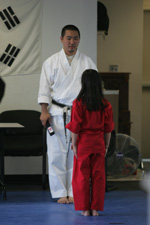

Kano's ultimate concern was for the well-being of the harmonized individual and of the entire community, reflected in his teaching methods and in judo's guiding principle of mutual benefit and prosperity. The diligent practice of Judo, Kano maintained, leads to the realization that one cannot progress at the expense of others, that mutual wellbeing is the key to any real progress in human life. Kano regarded the diffusion of this principle, through the practice of judo, as his greatest mission in life.
Genuine judo, distinguished from the Olympic-style martial art system it has degenerated into, begins with teaching the participants to avoid physical injury. When I studied with a private judo master while pursuing graduate study at Yale University, the first thing he taught me was to slap the practice mat with my arm to break the fall. Each participant helps to make sure that the other person does not experience physical pain or injury. Note in the image on the left that the person falling has his hand out ready to slap the mat to break his fall and the other participant is holding onto him to lessen his fall.
In authentic judo and aikido, the purpose is to learn suppleness of thought and motion, not the physical overpowering of an opponent. Unfortunately, Kano's original system of judo--involving moral, spiritual, and physical learning--has largely been replaced by a ferocious martial arts scheme now more akin to jujutsu and karate.
"One who has attained mastery of an art reveals it in every action."
Judo Maxim
Contemporary Examples of Psychic and Spiritual "Judo" In the current world, one of our formidable opponents is the demonic cabal and its minions, especially the Trump, Obama, and Bush II puppet regimes. We'll review several recent instances of psychic and spiritual "judo" that have been used to expose and discredit these opponents.

When gramps goes to church Easter day,
Encouraged by Trumpers to pray.
If he's felled by 19,
His heirs will then keen,
He died for our 401K! 10

At times, simply displaying the images of the public relations swindles that the Bush junta pulled off was the best way to expose their perfidy. After Bush's announcement of "mission accomplished," thousands of American service personnel continued to die in Iraq --so Bush's pals could steal Iraq's oil.
The Perennialist "judo" operation below began with a person's inspiration that American citizens were not comprehending the treachery and depravity of the Bush junta, the Obama swindle, and the Trump attrocities, and therefore weren't responding with appropriate outrage. Note that the title is "Ode to the People." In other words, it was not a direct, emotion-driven attack against a vile opponent but a stimulation of the people against enemies who are murdering them.
Ode to the People
Vulgar curses, jeers, stinging insults, cat-callsShould erupt whenever the smirking con-man
Affronts our nostrils with his scurrilous lies,
Corruption, death-stench.
By Michelle Mairesse
Philosophy, in Plato's time and ours, comes into being as the resistance of the soul to its destruction by a deranged world. Philosophy, as the continuing, most effective embodiment of the Perennial Tradition, possesses two distinct expressions:
|
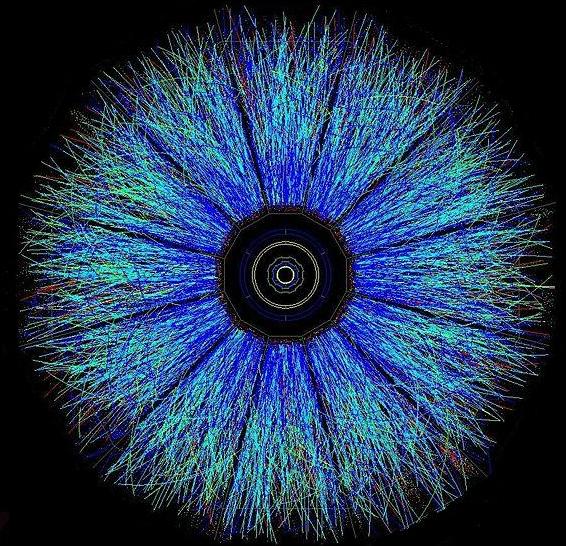
Notes1 The Perennial Tradition: the secret legacy, the single stream of initiatory teaching flowing through all the great schools of philosophy and mysticism; see the author's book: The Perennial Tradition
2 Hal Puthoff, Searching for the Universal Matrix in Metaphysics
3 Michael Talbot and David Bohm, The Holographic Universe
4 Carlos Castaneda, Journey to Ixtlan
5 Entrainment: An energy phenomenon in which weaker pulsations come under the influence of stronger ones.
6 "Sigmund Freud (1856-1939) is considered the father of psychoanalysis, which may be the granddaddy of all pseudoscientific psychotherapies, second only to Scientology as the champion purveyor of false and misleading claims about the mind, mental health, and mental illness. For example, in psychoanalysis schizophrenia and depression are not brain disorders, but narcissistic disorders. Autism and other brain disorders are not brain problems but mothering problems. These illnesses do not require pharmacological or behavioral treatment. They require only 'talk' therapy. Similar positions are taken for anorexia nervosa and Tourette's syndrome. (Hines 1990: 136) What is the scientific evidence for the psychoanalytic view of these mental illnesses and their proper treatment? There is none." The Skeptic's Dictionary
7 To get a clear view of what a morass of superstition and devastation psychoanalysis was--and is--I'd recommend your reading Wilhelm Reich's The Discovery of the Orgone.
8 Only classical music by such composers as Beethoven, Bach, Chopin, Handel, and Tchaikovsky and some "popular music," such as that created by George Gershwin, Cole Porter, and others of a high quality can be considered to be enlightening. One has only to view the grammy awards to see that current "music" is not only nothing but noise but is destructive of the understanding and appreciation of genuine music.
9 On the other hand, if you have the good fortune to interact with an advanced person, such as a Perennialist teacher or advanced seeker, you may feel a loss of your "false energy"--self-importance, priggishness, or sanctimoniousness--because your debilitating self is being exposed.
10 A person cannot be said to be cultured, civilized, intelligent, well-educated--some even say, decent--unless they have, in memory, a special, select group of limericks, such as this one:
An Epicure dining at Crewe,
Found quite a large mouse in his stew.
Said the waiter, "Don't shout,
"And wave it about.
"Or the rest will be wanting one too."

